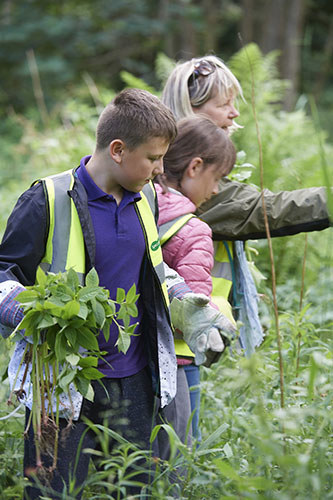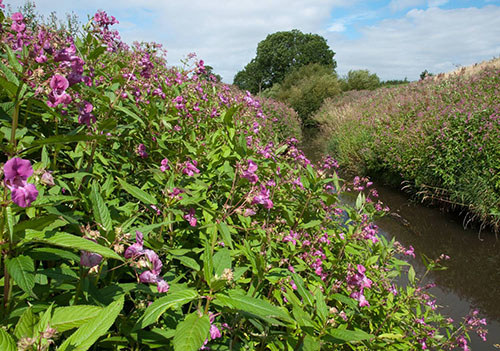This week is national Invasive Species Week, 13-17 May, which aims to raise awareness across Great Britain about invasive species and their impacts. Vicky Hilton from the Scottish Invasive Species Initiative explains more in this latest blog.
Vicky Hilton , Scottish Invasive Species Initiative
May 13, 2019
Being a project all about invasive species, here at the Scottish Invasive Species Initiative, we’re quite excited about having a whole week of lots of people talking about Invasive Species and we’d love everyone to share in our enthusiasm and learn something new during the week. For example, did you know:
- The estimated total annual costs of invasive non-native species to Scotland is more than £250 million?
- Giant hogweed leaves, which contain skin-burning sap, can grow up to 1m wide?
- Predation by the invasive American mink was one of the main factors in the staggering 94% decline in native water vole populations?
- The American skunk-cabbage plant does actually smell as bad as a skunk.
What is an invasive species?
 There are around 2,000 non-native plants and animals in the UK, these non-native species are species that have been transported here from their native range with the assistance of humans (either deliberately or accidentally). Of these only 10-15% go on to cause problems, having a negative impact on our environment, our economy or our way of life – these are termed as invasive non-native species.
There are around 2,000 non-native plants and animals in the UK, these non-native species are species that have been transported here from their native range with the assistance of humans (either deliberately or accidentally). Of these only 10-15% go on to cause problems, having a negative impact on our environment, our economy or our way of life – these are termed as invasive non-native species.
Why are invasives problematic?
Invasive species are problematic because they thrive in the new environment into which they’ve been introduced and, in doing so, impact on and disrupt the delicate balance of that natural ecosystem. Their impacts can be large and obvious, like the presence of a stand of Japanese knotweed, or subtle like the reduction in invertebrate biodiversity in a river when the banks are dominated by Himalayan balsam.
What makes a successful invader?
Most non-native species that go onto become invasive share several characteristics that make them successful in their new environment.
- They lack predators, pathogens or diseases that would keep their population numbers in check e.g. the American mink has no predators in Great Britain.
- They reproduce quickly, easily and in abundance e.g. giant hogweed produces 20,000-30,000 seeds per flower head.
- They are successful dispersers e.g. Himalayan balsam has exploding seed pods that spread its seed several meters, and a female mink can travel 80km in search of a breeding territory.
In addition, invasive plants often readily thrive on disturbed soils and making them very opportunistic and able to rapidly colonise a new area. They are usually fast growing, can be taller with larger leaves than native species and the have a longer photosynthetic period, they are the first out in leaf in the spring and last to die back in autumn. Some invasive plants also alter soil and habitat conditions where they grow to better suit their own survival and expansion.
All or some of these characteristics in combination make successful invasive species formidable opponents to native species – and difficult (and often expensive) to remove or dislodge once established.
What impacts do they have?
The most significant impacts invasive species have are on our natural environment where we see:
- Competition - invasive species are often better adapted to their new environment, growing faster and out-competing our native species for space and food/nutrients (e.g. invasive plants out-compete our native wildflowers).
- Predation - a predatory invasive species can have a significant effect on reducing the population of a native species (e.g. the significant impact on water voles by American mink predation).
- Hybridisation - invasive species can interbreed with native species, diluting the native gene pools (e.g. non-native Sika deer are interbreeding with our native Red deer).
- Habitat alteration - invasive species can alter invaded habitats (e.g. where Himalayan balsam forms dense stands on river banks, these die back in the winter leaving bare soil which is prone to erosion, which can contribute to flooding problems).
- Spread of disease - invasive species can carry pathogens and parasites to which our native wildlife has no or limited resistance (e.g. the grey squirrel carries the Squirrel pox virus, which has no effect on grey squirrels but is fatal to our native red squirrels).
 Invasive non-native species are having a significant cost to our economy. They are estimated to cost in the region of £2 billion a year in Great Britain. Costs are incurred by the agriculture, forestry and horticulture sectors, but also by many other sectors including transport, construction, aquaculture, recreation and utilities.
Invasive non-native species are having a significant cost to our economy. They are estimated to cost in the region of £2 billion a year in Great Britain. Costs are incurred by the agriculture, forestry and horticulture sectors, but also by many other sectors including transport, construction, aquaculture, recreation and utilities.
Some invasive species threaten our health or enjoyment of our environment. Rats, house mice and cockroaches are all invasive non-native species that can be serious house pests, and giant hogweed contains a phototoxic sap which causes serious skin burns on contact. Invasive plant species growing along river banks can spoil our enjoyment of the countryside, making it less appealing and restricting access for walkers and anglers.
What can I do?
Invasive species are a huge challenge in terms of management and removal – and we need to work together to be effective. The most effective measure is to prevent their introduction in the first place. However, everyone can play a role in this important battle.
- Be Plant Wise! – don’t let any non-native species escape from your garden and don’t dump garden waste in the countryside. This is how many invasive plant species have spread into the wild.
- Practise good biosecurity – make sure if you are walking, mountain biking, angling, kayaking, boating etc. that you ‘Check, Clean, Dry’ all your equipment and footwear between visiting sites. This helps stop the spread of invasive species and diseases.
- Get hands-on and volunteer – there are lots of ways you can practically help; join in a conservation volunteer activity to remove invasive species or undertaken habitat restoration work, adopt a mink monitoring raft or help survey for invasive plants.
- Be aware of the problem species to look out for in the countryside, record your sightings and report what you’ve seen. (If you are not aware of a local contact or specific project to directly report your sightings to, record them via the “iRecord” website or App).
There are also lots of ways to get involved in Invasive Species Week or in our project at any time, you can join in with a hands-on volunteering session to remove invasive plants, adopt a mink raft, go on a guided walk or drop in on one of the pop-up stalls. Our programme of events can be viewed on our website.
We’ll be posting lots more information and facts this week about invasives species and what you can do to help, on our social media channels, so if you want to learn more follow us on Facebook, Twitter and Instagram.
The Scottish Invasive Species Initiative is a four-year partnership project led by Scottish Natural Heritage and with many Fishery Boards and Trusts and the University of Aberdeen as partners. SISI is funded by the National Lottery Heritage Fund and NatureScot. To find out more, visit the project website where you can also sign up to the e-newsletter, follow on social media or contact us on sisi@nature.scot
Adobe Acrobat Reader is the free, trusted leader for reliably viewing, annotating and signing PDFs.
Download Adobe Acrobat Reader

 There are around 2,000 non-native plants and animals in the UK, these non-native species are species that have been transported here from their native range with the assistance of humans (either deliberately or accidentally). Of these only 10-15% go on to cause problems, having a negative impact on our environment, our economy or our way of life – these are termed as invasive non-native species.
There are around 2,000 non-native plants and animals in the UK, these non-native species are species that have been transported here from their native range with the assistance of humans (either deliberately or accidentally). Of these only 10-15% go on to cause problems, having a negative impact on our environment, our economy or our way of life – these are termed as invasive non-native species. Invasive non-native species are having a significant cost to our economy. They are estimated to cost in the region of £2 billion a year in Great Britain. Costs are incurred by the agriculture, forestry and horticulture sectors, but also by many other sectors including transport, construction, aquaculture, recreation and utilities.
Invasive non-native species are having a significant cost to our economy. They are estimated to cost in the region of £2 billion a year in Great Britain. Costs are incurred by the agriculture, forestry and horticulture sectors, but also by many other sectors including transport, construction, aquaculture, recreation and utilities.